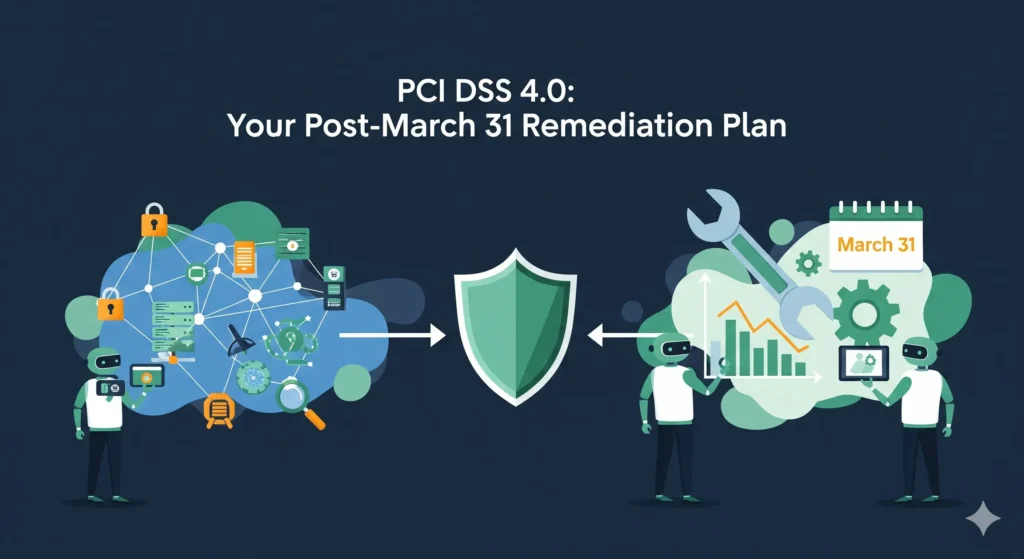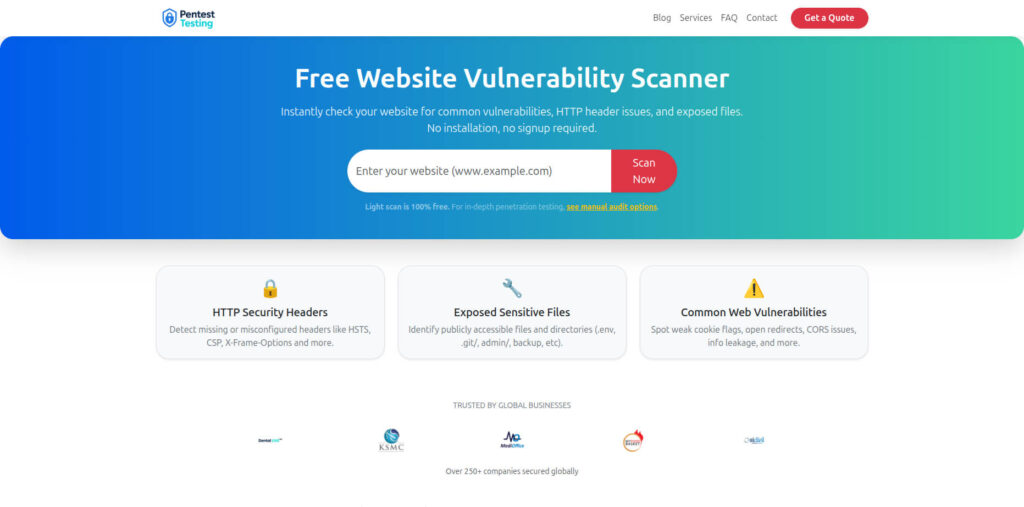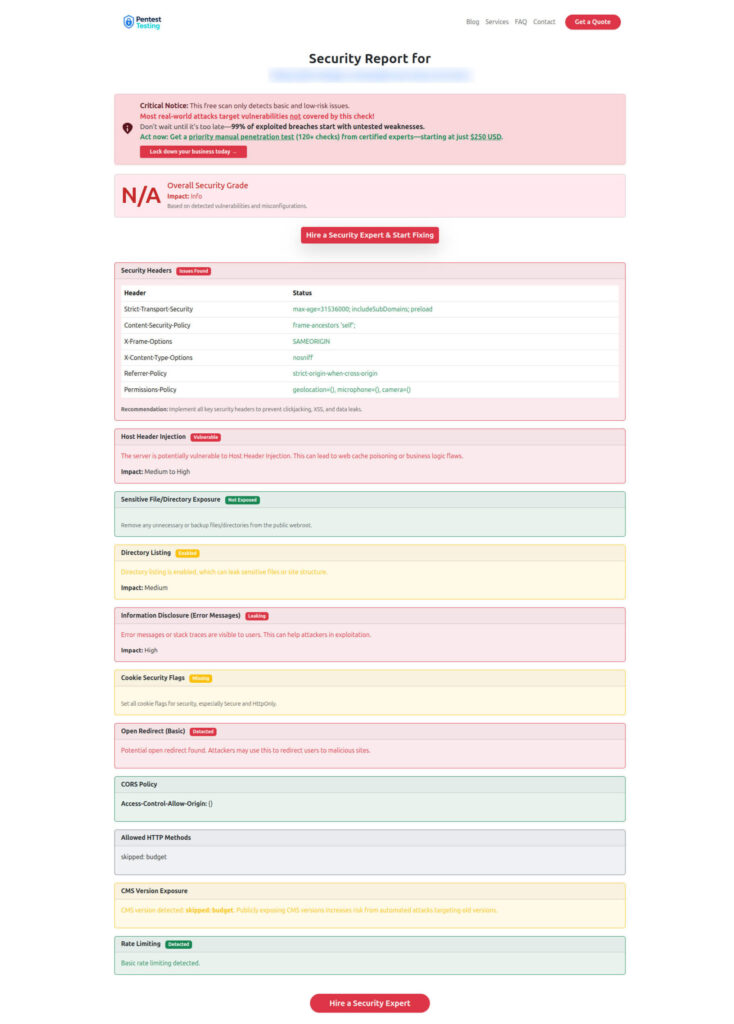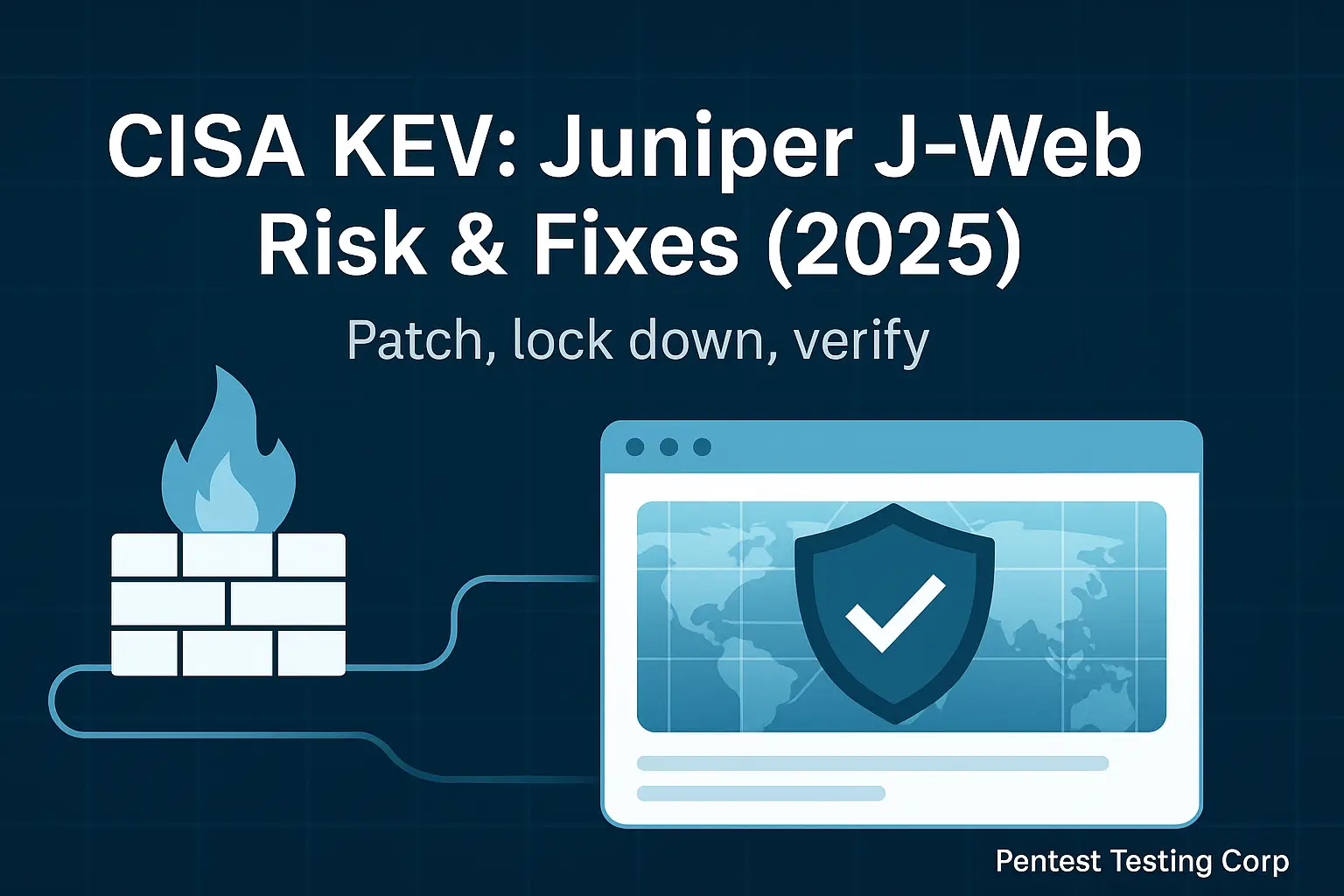PCI DSS 4.0: Your Post-March 31 Remediation Plan
You made it through March 31, 2025—now the real work starts. PCI DSS 4.0’s future-dated controls are no longer “best practice”—they’re mandatory. Below is a practical, QSA-friendly remediation plan you can execute in 30/60/90 days, with the exact evidence auditors expect and how to schedule verification testing so your next attestation is smooth.

Quick context: PCI DSS v4.0.1 is the current version. It did not change the March 31, 2025 effective date for the new requirements. (PCI Perspectives)
What actually changed on Mar 31, 2025—and what QSAs will look for
- Future-dated requirements are now in scope. PCI SSC confirmed that most of the new requirements deferred in 2022 became effective March 31, 2025. (51 of 64 new requirements were future-dated.) Expect your assessor to test against them this cycle.
- v4.0.1 housekeeping, not a reset. v4.0.1 clarified language and definitions (e.g., phishing-resistant authentication) but didn’t add/remove requirements or push dates. Use it as your reference going forward.
- Hot-button areas this year:
- MFA for all access into the CDE (not just remote admins). This shows up explicitly across SAQs and will be tested in RoC/AoC workpapers.
- Logging & reviews with automation for specified systems/events and TRA-driven frequency for others (Req. 10).
- Vulnerability management timeframes and “address/resolve” expectations under Req. 6 & 11.
- E-commerce payment-page script controls (Req. 6.4.3 / 11.6.1). Even where SAQ A reporting changed, the underlying requirements in the Standard still apply.
PCI Perspectives: what QSAs will scan for (+2 quick flags)
- Consistency: Policies, TRAs, and technical configs must tell the same story. If your TRA says daily log review for X, your SIEM schedule should show it.
- Closure proof: Tickets that end in “won’t fix” without a documented risk acceptance (and owner/date/expiry) are red flags.
Free Website Vulnerability Scanner: Free scan = fast wins: headers, TLS, and exposure checks.

Your 30 / 60 / 90-day PCI DSS 4.0 remediation sprint
Days 0–30: Stabilize access, visibility, and cadence
- Access & MFA
- Enforce MFA for all access into the CDE (human and non-human where applicable). Validate break-glass flows and service accounts. Export enforcement reports from IdP/VA and keep screenshots.
- Logging & monitoring
- Turn on centralized log collection for all in-scope systems. Configure automated log reviews for the events/components the Standard calls out; set TRA-based intervals for everything else. Save config exports and sample review outputs.
- External attack surface & ASV cadence
- Inventory Internet-facing assets that touch redirects/iframes to payment processors. Kick off ASV scans and put a recurring quarterly schedule in your calendar now; retain passing scan evidence.
- Quick wins via pre-assessment
- Run a free outside-in check to catch easy headers/TLS and CMS issues before your QSA: try our Free Website Security Scanner and document fixes with before/after screenshots.
Days 31–60: Close the high-risk gaps
- Vulnerability management
- Patch/mitigate Critical/High findings; document risk-ranking and due dates. Where fixes require change windows, track exceptions with end dates. (PCI SSC’s vulnerability-management guidance reinforces prompt identification and resolution.)
- Authenticated internal scans & rescans
- Ensure authenticated scanning is active for in-scope systems. After significant changes, re-scan until clean—this is explicitly split in v4 between internal (11.3.1.3) and external (11.3.2.1) rescans.
- Payment-page scripts (e-commerce)
- Implement script inventory/authorization and tamper detection (e.g., SRI, CSP reporting, file-integrity) for checkout pages. Keep change approvals and CSP/SRI configs as artifacts. (Even if SAQ A reporting changed, the Standard’s requirements remain.)
- Custom/bespoke software
- Maintain inventories, secure SDLC practices, manual code reviews for bespoke/custom components per v4 updates. Keep training logs and review checklists.
Days 61–90: Prove it works (and will keep working)
- Penetration testing & fix-verify
- If your annual/after-change pen test is due, schedule it now and track remediation + retesting to closure; retain reports and validation notes with timestamps.
- Targeted Risk Analyses (TRAs)
- Where v4 allows TRA-based frequencies (malware reviews, log reviews, etc.), finalize TRAs and point your monitoring jobs to those intervals. Keep approvals and version history.
- Documentation refresh
- Update policies, procedures, and runbooks to v4.0.1 terminology (e.g., phishing-resistant authentication). Store signed, dated versions.
- Control owners’ drill
- Do a mini-tabletop: each control owner walks through “show me your evidence for last quarter.” Capture gaps and fix before the assessor arrives.
PCI Perspectives: auditor pet peeves (+2 to avoid)
- Stale artifacts: Evidence older than the required cadence (e.g., “quarterly” that’s five months old).
- Undated screenshots: Always include timestamps or immutable report metadata.
Auditor-ready evidence: issues, fixes, and retest notes—on one page. Use this to check Website Vulnerability.

The evidence that satisfies auditors (make this your checklist)
- Remediation tickets that trace a finding → fix (or formal risk acceptance) → closure date → responsible owner.
- Re-test artifacts:
- ASV: Passing quarterly reports and post-change rescans where applicable.
- Internal scans: Authenticated scan results and post-change rescans until clean.
- Pen tests: Final report + verified closure of exploitable paths.
- MFA/Access: IdP policies, group mappings, exception process for break-glass accounts.
- Logging: SIEM rules/screenshots showing automated reviews for specified systems/events; TRA for others with evidence you followed the schedule.
- E-commerce scripts: Script inventory, authorization method, CSP/SRI configs, integrity-alert samples.
- Compensating controls (if truly needed): Complete the Compensating Controls Worksheet (Appendix B) and “In Place with Remediation” narrative (Appendix C) correctly.
Schedule your verification testing now (before attestation)
Lock the calendar today:
- External (ASV) scans: recurring every 90 days minimum, plus after significant changes; maintain passing proof.
- Internal authenticated scans: per policy cadence (at least quarterly is common) and after significant changes with rescans.
- Penetration testing: at least annually and after significant changes; keep methodology and 12-month retention of results.
If any scan fails, re-test until passing and tie the passing report to the remediation ticket. (That’s what your assessor will ask for.)
Need help prioritizing?
- Start with a risk assessment to target the controls that move the needle fastest: PCI DSS Assessment Services
- Hand off the heavy lifting to a team that lives and breathes PCI fixes: PCI DSS Remediation Services
- Browse more how-tos and checklists on our blog: Pentest Testing Corp Blog
- Recent Blog: Citrix NetScaler CVE-2025-7775
- Quick outside-in sanity check before you call your QSA: Free Website Vulnerability Scanner
Also see our sister site’s articles for practical developer-level hardening: Cyber Rely Blog.
Handy references for your governance pack
- PCI SSC: “Just Published: PCI DSS v4.0.1” — confirms v4.0.1 didn’t change the 31 Mar 2025 effective date and summarizes clarifications. (PCI Perspectives)
- PCI SSC: “Now is the Time to Adopt the Future-Dated Requirements” — context that 51/64 new requirements became effective 31 Mar 2025. (PCI Perspectives)
- PCI SSC: SAQ updates & examples — MFA for all CDE access; log review automation/TRA; payment-page script protections. (PCI Perspectives)
- PCI SSC: Vulnerability Scans & ASV Resource Guide — quarterly ASV evidence requirement for SAQ A e-commerce sites. (PCI Perspectives)
- PCI SSC: Summary of Changes v3.2.1 → v4.0 — separates internal (11.3.1.3) and external (11.3.2.1) post-change rescans. (PCI Security Standards Council)
Final word
Treat this year like a product launch sprint: tighten access, make logging actionable, get your scanning drumbeat steady, and prove every fix. Do that, and your PCI DSS 4.0 remediation story will stand up to QSA scrutiny—and you’ll pass faster with fewer surprises.

